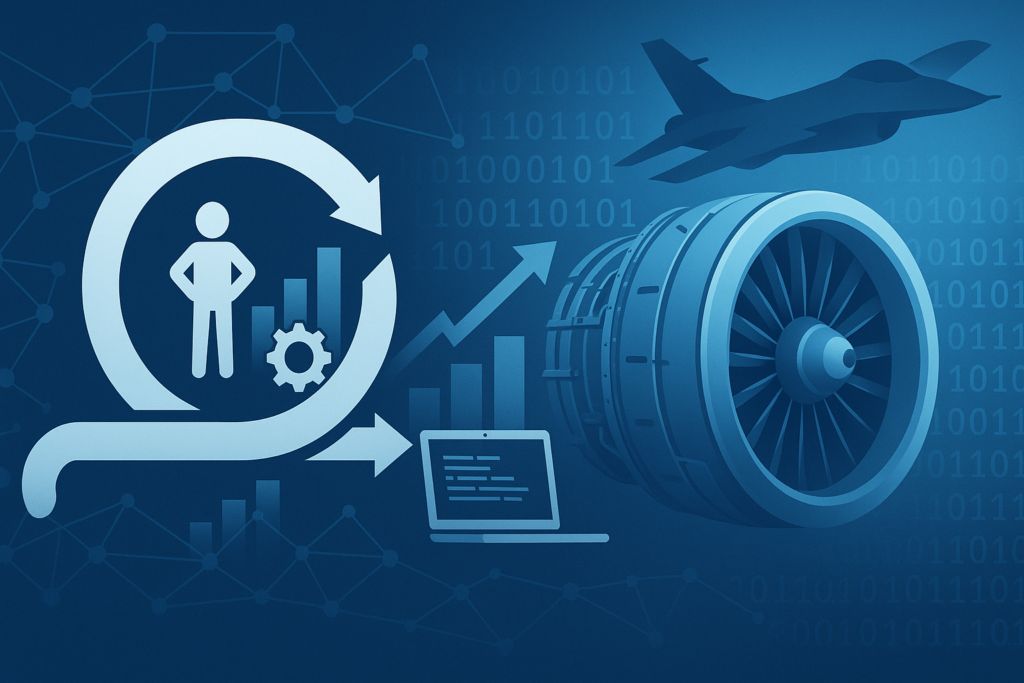
For most of our lifetimes, the military and defense industries have been focused on one guiding principle: stability. Leadership lives in a world of high-stakes decisions where risk isn’t primarily focused around dollars but it revolves around lives and national security. They build and maintain expensive and expansive systems that can take decades to build and certify. The result has been long timelines, highly regimented processes, and carefully controlled and conservative workflows. As technology develops and world becomes more volatile, the old model is struggling to keep up.
Digital transformation is a necessity for aerospace and defense moving forward. Digital Transformation is essential whether we are building and improving AI-powered systems, deploying autonomous drones, or innovating and adapting to software-defined warfare. With each day it becomes more apparent that defense and aerospace organizations must evolve. This is where Agile principles come in. Agile was developed to help software teams move faster and build smarter and Agile’s strategies and approach is ideal for recreating one of the most traditionally rigid sectors to compete as we move into a technologically superior era.
Agile is more than just a change of strategy or a technique, it’s a culture and a mindset shift. Agile encourages teams to break down big problems into smaller parts, build iteratively, and constantly gather feedback. For industries used to five-year plans and waterfall delivery, this is a radical change, and one that’s proving to be a powerful one. By adopting Agile, teams can deliver working software (or hardware/software combinations) in months, not years, and adjust on the fly based on new data, shifting requirements, or real-time mission needs.
We’re already seeing real-world examples of Agile in action across the sector. NASA’s Jet Propulsion Lab, for instance, uses Agile practices to manage complex software systems that support space missions. Agile allows them to adapt quickly, even in missions where stakes are literally astronomical. In the U.S. Air Force, the Kessel Run unit has become a model for Agile transformation. They’ve built software that supports flight operations, refueling logistics, and battle planning, all using two-week sprints, DevSecOps pipelines, and constant iteration. This is a far cry from the legacy systems that used to take years to deliver, and it’s had a real operational impact.
Of course, the path hasn’t been smooth. Agile in aerospace and defense comes with real challenges. These are industries bound by regulation, safety certification, security clearances, and multi-billion-dollar contracts. You can’t just throw out documentation and call it innovation. Many Agile practices have had to be adapted or hybridized to work within these constraints. But we need to start diving in full force. Agile isn’t about dogma, it’s about outcomes. And more and more, leaders in the space are realizing that Agile doesn’t mean giving up rigor, but it means creating a system that’s built to respond to change rather than resist it.
Digital Transformation is not just about adopting cloud, AI, or edge computing. Those are tools. The real transformation comes when teams change how they think, how they build, how they communicate, work together, challenge each other, and how they deliver. Agile gives them that framework. It enables faster iteration, closer collaboration, and more continuous delivery, things that are absolutely vital as threats evolve and technologies move faster than ever before.
In the past, defense projects competed based on scale and complexity and as we move forward, they’ll be judged based on speed, flexibility, and adaptability. Agile enables all three. It’s not just a better way to build software. It’s becoming the foundation for how modern defense systems, aircraft, and mission-critical platforms are imagined, developed, and deployed.
The future of aerospace and defense is fast, digital, and iterative. Agile is the bridge that’s helping these industries cross over—and those that embrace it now will be best positioned to lead in the years ahead.
www.digitaltransformations.com
